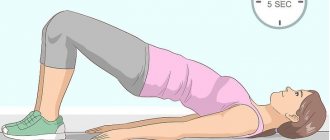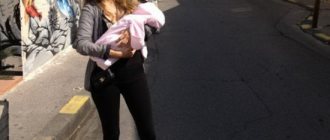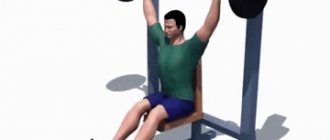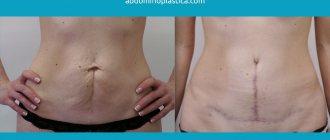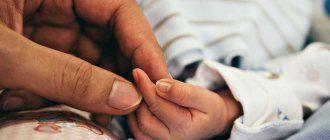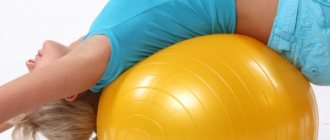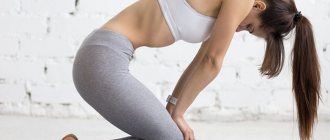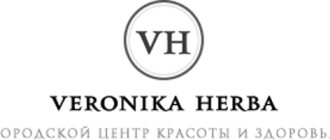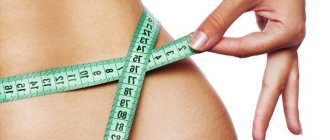Stages of recovery after childbirth
The understandable desire of a new mother is to regain her lost shape as quickly as possible after childbirth. However, early physical activity, according to gynecologists, can lead to complications. After the birth of a baby, a woman’s body experiences a number of significant changes:
- the uterus gradually contracts and returns to its normal size;
- after separation of the placenta, a wound remains inside the reproductive organ, which heals over time;
- pelvic bones and internal organs, displaced during pregnancy, return to their places.
Immediately after childbirth, playing sports is unacceptable; the main reason for the ban is the high risk of uterine bleeding.
Why are muscles needed and where do they disappear?
Our musculoskeletal system consists of bones, ligaments and muscles. Joints are formed where bones meet. Muscles hold bones in the required position relative to each other and allow us to move. That is, the first function is maintaining posture and moving . Muscles also support internal organs. Often, the internal organs themselves consist of muscle tissue, for example the heart, uterus, intestines, etc. That is, the third function of muscles is structural .
Muscle tissue is very active metabolically. At rest, she consumes a lot of energy, about 13 kcal per hour per 1 kilogram of weight. By the way, adipose tissue consumes 2 times less energy. Thus, if the number of muscles in the body increases, then the metabolism will speed up, and quite significantly - up to 50%. For a real person, this means that you can finally eat pasta with meat and not gain weight.
Where can our muscles disappear?
- Age . Every year the percentage of muscle tissue in the body inexorably falls.
- Hormonal changes . Stress hormones promote active breakdown of muscle tissue. “Pregnant” hormones work on the same principle (have you noticed that many mothers’ butts disappear somewhere?).
- Hunger . Nothing destroys our muscles like a low-calorie diet. With each session of some kind of diet with two sprigs of parsley, tea and an egg in the daily diet, the muscles become smaller and smaller.
- Inaction . As we have already said, muscle tissue is quite gluttonous. So why keep such a glutton who does nothing?
But what should we do? How to stop this process of catabolism (breakdown, breakdown) of muscle tissue?
Let's look at the list above. We cannot control the first point. The second - indirectly, for example, by changing your attitude towards stressful situations. The third and fourth are completely in our control. And, what’s most amazing! A balanced diet plus active muscle work can not only stop, but also reverse the processes of catabolism!
With nutrition, everything is clear, today everyone knows that all nutrients are needed for health: proteins, fats, and carbohydrates, and in a certain ratio. But we haven’t figured out physical activity yet. It would seem that there is nothing more active than cardio - hail sweat, fatigue and brutal hunger after a workout aren’t these the best indicators of good work? But no. Cyclic activities (running, exercise bike, elliptical, jumping, etc.) do not load the muscles. They put stress on the cardiovascular and respiratory systems. The muscles are used very sparingly.
Strength exercises involve many times more muscle fibers. That's why they're so hard to do. Moreover! Strength exercises, especially with weights, lead to the fact that energy is wasted not only during the activity, but also for a day or more after physical activity.
When can you return to sports after childbirth?
Pregnancy for every woman is a complex process associated with hormonal changes throughout the body. A lack of vitamin and mineral components caused by the baby's intrauterine development, a large load on the spine, muscle strain, and excess weight can cause stress and depressed mood.
The time for complete recovery is individual for each woman, depending on the age and physical health of the young mother. Postpartum fatigue, constant care, anxiety about the newborn, and decreased vital energy are not the best incentive to exercise. For a nursing mother, it is important to listen to her own feelings and independently plan her day for physical exercise.
Experienced doctors do not prohibit fitness after childbirth, but do not recommend rushing too much. Heavy physical activity and sudden changes in activity can negatively affect your health. There is a risk of decreased breast milk production, and in severe cases, uterine bleeding is possible.
Gynecologists recommend starting exercises after natural birth, 1.5 months. If there were complications, surgical obstetric methods were used - no earlier than 3 months. It is important to follow the principle of gradually increasing loads.
Set of exercises
Before engaging in fitness after childbirth, consult your doctor - he will recommend the safest and most effective type of physical activity for you. As a rule, you can do Pilates and yoga within two to three weeks after giving birth. They will restore flexibility and strength to the body, but it is better to exercise under the guidance of an instructor who knows that you have recently given birth and you need gentle loads. If you've been working out at the gym before giving birth - either on your own or with a trainer - you can continue a few weeks after giving birth, but start with exercises that don't require too much effort.
Exercise 1 - Bridge and twist.
Lie on your back, bend your right leg at the knee , foot flat on the floor, arms along your body. Straighten your left leg, lift it to the level of your right knee and lift your buttocks and lower back off the floor. Then slowly lower your torso and return your left leg to mid-calf level. Raise your head, lift your neck and shoulders off the floor, stretch your arms forward as if you want to touch your foot. Lower to the starting position, repeat. Do one set of 8-10 repetitions. Change legs and do the exercise on the other side . Gradually increase the number of repetitions to 15 per set.
Exercise 2 – Body rotations.
Starting position : lying on your back, hands behind your head. Without lifting your feet from the bed, turn your torso and knees to the left, while extending your left arm to the side. Stay in this position for a few seconds . Return to the starting position. Repeat the exercise 3-5 times in each direction.
Exercise 3 – Bend overs with straight arms raised.
Hold a plastic water bottle in each hand, with your feet hip-width apart. Bend your knees slightly and lean forward, keeping your torso parallel to the floor. The arms hang straight down, palms turned inward. Squeeze your shoulder blades together, then pause . Take your arms back, behind your back, do not straighten your elbows completely, do not turn your hands. (On your last rep, hold this position for a few counts.) Slowly lower your arms back to the starting position. Perform one set of 8-12 repetitions. Over time, increase the number of repetitions to 15.
Exercise 4 – Shallow plie.
Stand straight, heels together, toes apart. Place your hands on your belt, tense your abs, your tailbone “looks” at the floor. Without changing your body position, bend your knees and slowly squat as deep as you can ; do not relax your muscles. Straighten your legs, rising on your toes. Lower your feet to the floor and repeat the exercise. Do one set of 12-15 repetitions, gradually increase the number of repetitions to 20.
Exercise 5 – Kitty.
Starting position : standing on all fours (knee-wrist position), shoulders and pelvis are on the same line. The knees are placed a short distance apart. As you exhale, we draw in your stomach , while simultaneously raising your left knee and right palm. While inhaling, we return to the starting position . Then we change the “diagonal” - we raise the right knee and left palm. Let's repeat 10-12 times.
Exercise 6 – Leg swings.
Shift your center of gravity to your left leg, lift your right leg forward. Hold this position for a second, lower your foot and move it back. In this position, bend your left leg at the knee, then slowly straighten it. Do one set of 12-15 repetitions on each leg (during one repetition, you should swing your leg back, forward and bend the other leg at the knee). Gradually increase the number of repetitions to 20.
Exercise 7 – Waist bends.
Starting position : lying on your back, legs bent at the knees, feet on the bed. As you exhale, pulling your socks towards you , at the same time we reach with your left hand towards your left foot. While inhaling, we return to the starting position . Once again, as you exhale, pulling your socks towards you, at the same time we reach with your right hand towards your right foot. We return to the starting position. The hands seem to glide along the surface; there is no need to lift the chest or lift the heels from the surface. Repeat 5-6 times in each direction.
Stretching exercises will also be very useful.
Types of activities for classes: pros and cons
When asked whether a nursing mother can engage in fitness, doctors answer in the affirmative. A preliminary consultation with a gynecologist, who will examine the tone of the uterus and the woman’s general well-being, will help you choose a sport. In the absence of contraindications, the intensity of training, the level of load is calculated individually. The list of sports and exercises prohibited for a young mother includes:
- Weightlifting;
- distance running;
- cycling;
- kayaking;
- Skydiving;
- heavy loads on the abdominal muscles.
You should be careful with active sports games: volleyball, basketball, football, tennis, which are characterized by sudden movements and quick changes of direction. Recommended recovery activities include:
- Pilates: a subtype of fitness with smooth and slow movements that effectively help with regular training to get rid of folds on the stomach and sides;
- yoga: proper performance of asanas helps to increase vitality, improve mood, helps to relax and recharge with positive energy;
- walking: a simple and effective training method for tightening muscles, goes well with daily walks with your baby;
- swimming: complex work of all muscle groups without static load on the spine;
- dancing, including oriental dancing: belly dancing helps restore muscle elasticity, body plasticity, and flexibility.
How to combine exercise and child care?
A woman who has recently given birth to a child, especially if it is her first child, does not always understand where to find time for exercise in her busy daily routine.
If a nursing mother has no time to exercise after giving birth, you can try doing exercises with your baby. Such gymnastics will take the form of a game, and the child will not be left without supervision.
To properly combine maternal responsibilities and physical activity, you need to adhere to the following principles:
- train in those moments when the baby is awake (after performing all hygiene procedures), the baby can be placed next to him so that he watches the mother;
- perform those exercises that are possible together with the child (for example, lying on your back, lifting the baby with outstretched arms: the pectoral muscles will be strengthened and the baby will be delighted);
- be sure to go to bed to rest during the day with your baby (especially during a long nap at lunchtime);
- do not neglect daily walks, which should be done twice a day for 1 hour in winter and 2-3 hours in summer: the baby can rest comfortably in the stroller or look around. At this time, mom can go for a light jog, walk quickly, or even do a series of lunges and hang on the horizontal bar in a deserted park.
House or hall
Having dealt with the questions of when you can start exercising, all that remains is to choose what is better - visiting a gym or the convenience of a home environment. Each option has advantages and disadvantages, namely:
- Gym . Pros: classes with an experienced professional trainer in a group with young mothers. All loads are correctly calculated, guaranteeing effective results without risk to health. Cons: the class schedule is strictly defined, without taking into account personal wishes, as well as financial costs.
- House . After consulting with a doctor, you can choose a set of exercises and start exercising at a convenient time, in comfortable conditions, while saving your family budget. Disadvantage: in the absence of self-discipline and large household responsibilities, classes will not be held regularly.
The final option depends entirely on life circumstances and the great desire of the woman herself. An excellent motivation for playing sports will be the baby, who, as he grows, will take an active part in activities with his mother.
Breast shape and sport
The mammary glands contain more than 90% fat, so its shape largely depends on the woman’s weight. Breasts full of milk look very impressive, but without proper training of the pectoral muscles, there is a high probability of sagging, which will cause the skin to overstretch and become flabby.
To prevent such a situation from occurring, you need to pay attention to the following factors:
- be sure to wear a comfortable bra that does not squeeze the mammary gland, but delicately supports it;
- regularly load the pectoral muscles with exercises aimed at training them;
- do not allow a strict diet, which will cause breast loss and sagging;
- include push-ups in your training plan, which have a beneficial effect on the appearance of your breasts.
Fitness after cesarean
Caesarean section is a surgical intervention in the process of childbirth, which took place with complications. Postoperative wounds are treated for a certain time, which determines the time frame for returning to sports. The recovery period, compared to natural childbirth, is longer, requiring the woman to pay increased attention to her own health. According to the recommendations of the gynecologist, you should start simple exercises no earlier than 3 months after the operation.
Small cuts and tears that occur during childbirth heal within a few weeks. When the baby turns 2 months old, you can start training. In the case of multiple injuries to the perineum, the ban on sports directly depends on the complexity and size of the tears. After suturing large wounds, you should postpone sports until complete recovery. Active training with full load after cesarean or ruptures is allowed no earlier than 6 months.
Consult your doctor
This needs to be done twice. The first time is when you just decide to return to classes. You need to make sure whether the suture has healed after a cesarean section or tears after a normal birth, and whether physical activity is safe for you. Go to a specialist for the second time a month after starting training: retell your feelings during training, this will help you adjust your physical activity plan. You must be absolutely sure that fitness classes are not harmful to you, and you are doing everything right.
Useful tips
During fitness classes, it is recommended to drink a lot of clean, still water to avoid dehydration. It is important for young mothers to eat right and walk a lot in the fresh air. It is especially useful to spend time in coniferous and deciduous parks, away from harmful emissions.
The first workouts after childbirth should be done in a gentle manner. First of all, it is important to pay attention to the abdominal area. Optimal exercises include Pilates or yoga, which further strengthen the pelvic floor muscles. With the help of a gymnastic complex, you can tone the lower abdominal muscles, stabilize the spine, and distribute the load on the musculoskeletal system of the body. At the second stage of physical activity, to achieve attractive forms, you should train the pelvic muscles. The final stage is exercises for the upper back and neck muscles. This complex is especially relevant during breastfeeding, as it helps stimulate lactation.
A set of exercises on a large exercise ball not only keeps your muscles toned, but also lifts your spirits. Simple and effective exercises on sports equipment do not require much physical effort. Rolling and twisting while sitting on a ball helps relieve tension in the back and works well on the lateral muscles in the waist.
An integrated approach to the training system, proper nutrition and a positive attitude will bring the expected results. Regular exercise will give you beauty and strength to enjoy the joy of motherhood.
Benefits of Fitness
The moment a woman becomes a mother, she notices that her body has changed a lot, and, most often, not for the better. Physical exercise will help you get into maximum shape from 2-3 months after giving birth. The main thing is to do exercises regularly and increase the load intensively.
To begin with, experts recommend doing yoga and Pilates - these techniques are especially good at strengthening the pelvic muscles; it will also be useful to perform exercises by the famous Dr. Kegel to restore tone to all female organs.
The impact of fitness on the body of a young mother:
- stabilizes the psychological state;
- restores all organs that were involved in childbirth;
- improves metabolism;
- improves lymph outflow and blood circulation;
- helps fight excess fat deposits;
- saturates cells with oxygen, which leads to improved condition of skin, hair and nails.
Fitness and breastfeeding
Some new mothers avoid any exercise for fear that their milk supply will decrease. But in the course of research, scientists have proven that sport has no negative impact on either lactation itself or the development of the baby.
The only point that needs to be taken into account is that intense physical activity can affect the composition of milk itself - it increases the lactic acid content. As a result, the child may not like the sour taste, but this does not always happen. To avoid breast refusal, it is recommended to simply limit yourself to moderate exercise and drink more water. Expressing milk half an hour to an hour after training also helps - it contains the largest amount of lactic acid, so it will not get to the baby.
